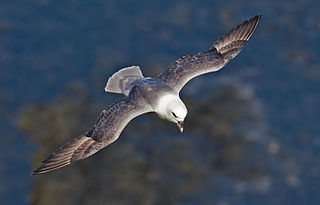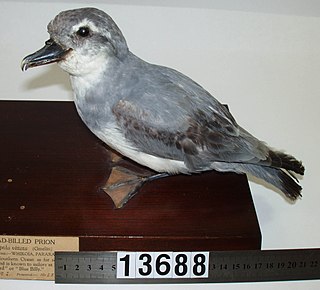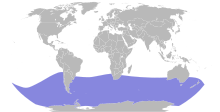
The fulmars are tubenosed seabirds of the family Procellariidae. The family consists of two extant species and two extinct fossil species from the Miocene.

Petrels are tube-nosed seabirds in the bird order Procellariiformes.

The northern fulmar, fulmar, or Arctic fulmar is a highly abundant seabird found primarily in subarctic regions of the North Atlantic and North Pacific oceans. There has been one confirmed sighting in the Southern Hemisphere, with a single bird seen south of New Zealand. Fulmars come in one of two color morphs: a light one, with white head and body and gray wings and tail, and a dark one, which is uniformly gray. Though similar in appearance to gulls, fulmars are in fact members of the family Procellariidae, which include petrels and shearwaters.

The Antarctic petrel is a boldly marked dark brown and white petrel, found in Antarctica, most commonly in the Ross and Weddell Seas. They eat Antarctic krill, fish, and small squid. They feed while swimming but can dive from both the surface and the air.

Giant petrels form a genus, Macronectes, from the family Procellariidae, which consists of two species. They are the largest birds of this family. Both species are restricted to the Southern Hemisphere, and though their distributions overlap significantly, with both species breeding on the Prince Edward Islands, Crozet Islands, Kerguelen Islands, Macquarie Island, and South Georgia, many southern giant petrels nest farther south, with colonies as far south as Antarctica. Giant petrels are extremely aggressive predators and scavengers, inspiring another common name, the stinker. South Sea whalers used to call them gluttons.

Procellaria is a genus of Southern Ocean long-winged seabirds related to prions, and within the order Procellariiformes. The black petrel ranges in the Pacific Ocean, and as far north as Central America. The spectacled petrel is confined to the Atlantic Ocean, and the Westland petrel to the Pacific Ocean. The white-chinned and grey petrel range throughout the higher latitudes of the Southern Ocean.

The blue petrel is a small seabird in the shearwater and petrel family, Procellariidae. This small petrel is the only member of the genus Halobaena, but is closely allied to the prions. It is distributed across the Southern Ocean but breeds at a few island sites, all close to the Antarctic Convergence zone.

The fulmarine petrels or fulmar-petrels are a distinct group of petrels within the family Procellariidae. They are the most variable of the four groups within the Procellariidae, differing greatly in size and biology. They do, however, have a unifying feature, their skull, and in particular their nasal tubes. They are predominantly found in the Southern Ocean with one species, the northern fulmar, ranging in the North Pacific and Atlantic Oceans.

The fairy prion is a small seabird with the standard prion plumage of blue-grey upperparts with a prominent dark "M" marking and white underneath. The sexes are alike. This is a small prion of the low subantarctic and subtropic seas.

The white-chinned petrel or Cape hen, is a large shearwater in the family Procellariidae. It ranges around the Southern Ocean as far north as southern Australia, Peru and Namibia, and breeds colonially on scattered islands. The white-chinned petrel was formerly considered to be conspecific with the spectacled petrel.

The broad-billed prion is a small pelagic seabird in the shearwater and petrel family, Procellariidae. It is the largest prion, with grey upperparts plumage, and white underparts. The sexes are alike. It ranges from the southeast Atlantic to New Zealand mainly near the Antarctic Convergence. In the south Atlantic it breeds on Tristan da Cunha and Gough Island; in the south Pacific it breeds on islands off the south coast of South Island, New Zealand and on the Chatham Islands. It has many other names that have been used such as blue-billed dove-petrel, broad-billed dove-petrel, long-billed prion, common prion, icebird, and whalebird.

The Antarctic prion also known as the dove prion, or totorore in Māori, is the largest of the prions, a genus of small petrels of the Southern Ocean.

The grey petrel, also called the brown petrel, pediunker or grey shearwater is a species of seabird in the Procellariidae, or petrel family. It is pelagic and occurs in the open seas of the Southern Hemisphere, mainly between 32°S and 58°S.

















